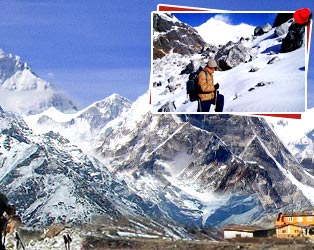Before knowing the weather condition of the Himalayan
region we should understand its geography. The Himalayan region covers
an area of 2,250 km with an average width of 200 km. The forest belt of
the Himalayan region consists of Oak, Rhododendron, Birch, Pine, Deodar,
and Fir. And the monsoon season in this region lasts for mid June till
the end of September. The Himalayas influences the meteorological
conditions in the Indian subcontinent to the south and in the Central
Asian highlands to the north to a great extent. It acts a climatic
divider circulating the air and water system to a great extent. Because
of its altitude and location it blocks the passage of the cold winds
coming from the north to the Indian sub continent thereby making India's
climate much more moderate. It also influences the rainfall pattern in
India. The combined effect of rainfall, latitude and altitude largely
influences the forests belts in the Himalayan region. The rainfall is
mostly recorded during the monsoon time of June to September but it
decreases as you travel from east to west. The snow-capped ranges of the
Himalayas stretch 2, 250 km from the Namcha Barwa to Nanga Parbat on the
Indus. The range extends from east to west up to central-Nepal and then
takes a southeast to northwest direction.
Climatic Variation of the Himalayas
The Himalayan region mainly experiences two season winter and summer.
The average summer temperature in the southern foothills is about 30
degree Celsius and the average winter temperature is around 18 degree
Celsius. In the middle Himalayan valleys the average summer temperature
is around 25 degree Celsius while the winters are really cold. And on
the higher region of the middle Himalayas the summer temperature is
recorded at around 15 to 18 degree Celsius while the winters are below
freezing point. The climatic condition at region above 4880 m is below
freezing point and it is permanently covered with snow. During the
winter the snowfall is really heavy while the summers are much more mild
and soothing. The Himalayan Alpine climate varies according to the
altitude. The more the height the more cooler the temperature gets here.
The climatic condition changes very quickly in the Himalayan region due
to change in the altitude. The climate here is very unpredictable and
dangerous too.
The regions of Ladakh and Zanskar situated in the North of the main
Himalayan range are unaware of the monsoon season as the average annual
rainfall is only a few centimeters as a result the humidity level is
very low in these regions. The region experiences one of the coldest
temperatures in the world during winter. Mostly the hill stations of the
Western Himalayas like Shimla, Kullu valley, Kangra and Chamba and some
regions in Uttaranchal like Kumaon and Garhwal experiences the Indian
monsoon. Even Darjeeling and Sikkim comes under Indian monsoon. The post
monsoon period in these regions are much more proper. So it can be
clearly understood that the Himalayan climate varies according to
altitude and location. It is truly a land of variations with so much
climatic variations to offer.



